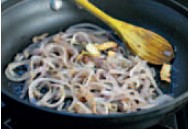Easy Indian Cooking (2 page)
Read Easy Indian Cooking Online
Authors: Hari Nayak


introduction
Traditional Indian cuisine has its own charm, its own signature dishes and its own stories. When we add the twist of contemporary presentation, a touch of native sensibilities and a dash of the global bounty, what you find before you is a kaleidoscope of delectable, modern, yet soul-stirring cuisine, I affectionately call this “easy Indian cooking.”
This book represents my take on modern Indian cuisine, marrying together the traditional Indian soul with the contemporary lifestyle. Whether cooked for family or guests, the recipes in this book alleviate that feeling of intimidation that is often associated with Indian cooking.
Easy Indian Cooking
re-creates classic Indian dishes using simple techniques along with a delicious juxtaposition of non-Indian ingredients. I have strived to bring traditional cuisine to accessible levels fit for modern living and entertaining, while keeping the flavors and authenticity intact.
Having traveled extensively within India, I'm able to offer you various distinctive styles that are unique to—and often characteristic of—different regions of the country. I've been mindful of the different ways we approach food, how we cook and eat, and the ingredients that are readily available at your local grocery. What results is a contemporary style of cooking great tasting food for easy entertaining and busy lifestyles. Through these recipes you'll experience the richly diverse, culturally beautiful country of India and the many flavors that it can bring to your table using locally available ingredients.
indian cooking techniques
The heart and soul of Indian cooking is the mastery of using unique and imaginative spices, seasonings and flavorings, and learning the nitty-gritty of Indian cooking techniques. You will already be familiar with many of these cooking techniques from your own everyday cooking. The main techniques are steaming (
dum
), tempering (
tarhka
), roasting (
bhunnana
), frying (
talna
) and sautéing (
bhunao
). Other common techniques are the roasting and grinding of spices, browning onions, garlic and meats, and handling sauces. Some or all of these methods may be necessary to prepare an Indian dish. They are not hard to master, but is important to understand the basic principles of each.
Browning
Most Indian recipes require the browning of onions fried over medium-high heat. Evenly browned onions are more flavorful and give sauces a desired rich, deep reddish-brown color. The same goes for garlic—the flavor of garlic is quite amazing if it is fried in oil until it turns golden brown. For the best flavor and color, meat is also browned. Browning also sears the meat, which makes it juicy. I like to brown marinated meat before combining it with other ingredients. If I am cooking a larger quantity, I brown a few pieces of meat at a time in hot oil and set them aside. I then add the browned meat and all the cooking juices back into the pan with the other ingredients and let it finish cooking in the sauce.



Deep-Frying
Talna
refers to deep-frying, Indian style. Generally, for deep-frying, Indian cooks use a
kadhai
—a deep pan with a rounded bottom similar to a wok. Unlike a deep fat fryer, the size and shape of the
kadhai
does not allow large quantities of food to be fried at one time, which results in even frying.
When deep-frying, oil should be heated to between 325° and 350°F (160° and 180°C). This is crucial—if the oil is too hot, the outside of the food will brown very quickly, leaving the inside uncooked; and, if the oil is not hot enough the foods will absorb oil and become greasy. When frying, do not overcrowd the pan; fry the food in batches, if necessary. Use a slotted spatula or spoon when removing fried food from the oil, and hold each piece against the edge of the pan for a few seconds. This allows excess oil to drain back into the pan. Place fried foods on a tray lined with paper towels to drain. To re-use the oil, let it cool completely. Using a fine-mesh strainer, strain the oil into an airtight container. Store the oil at room temperature.



